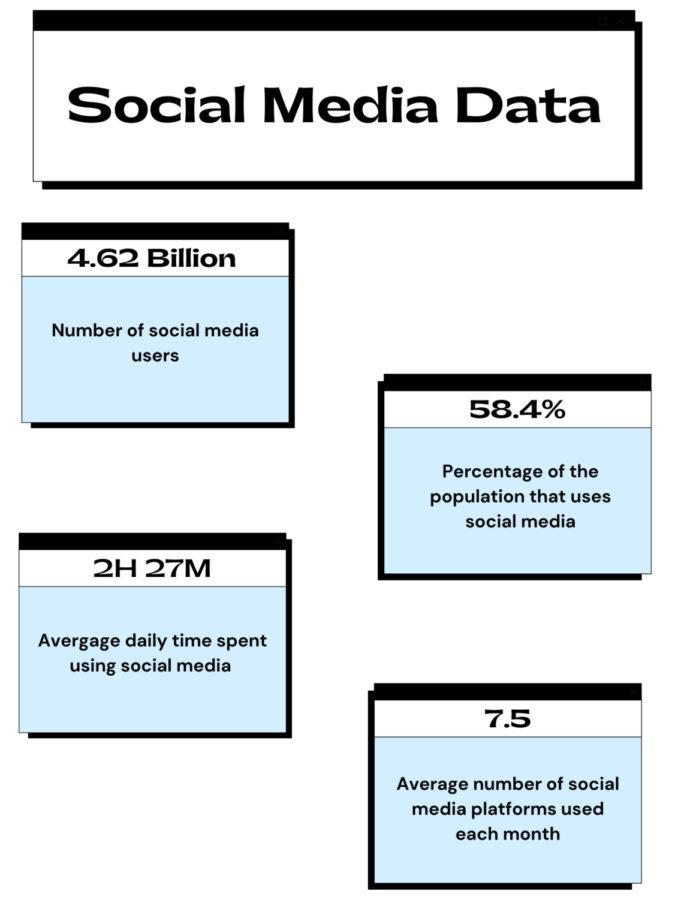Social media’s lack of creativity fuels addiction
October 16, 2022
Across the internet there are a wide variety of social media apps. Instagram, Facebook, Twitter, Snapchat, and TikTok are among the most popular today.
When thinking about these individual apps their differences can clearly be described. Instagram is for sharing photos, Facebook is for sharing life updates, Twitter is for written posts, Snapchat is for temporary messages and posts, and TikTok is for short video content.
All these apps may seem to have distinct purposes, however as social media has aged it has become common for platforms to take “inspiration” from one another. Whether it be a new app, or a popular new feature on an already existing one, developed platforms are quick to copy-and-paste.
Of course, copying is done to increase user engagement, which leads to bigger profits for these social media platforms. While the platforms themselves benefit from this copying habit, users are left to face the consequences of unoriginality.
Consumers are left with a multitude of apps that all have similar layouts yet different content to filter through. Such a task is not only overwhelming but ultimately leads to users spending an excessive amount of time online.
Having a variety of apps is often viewed as a good thing. Multiple platform options allow people with even the highest standards to find their preferred form of social media.
Social media is also a great tool for connecting with others, whether that be old friends, present day companions or even strangers.
Since social media allows users to share their thoughts and content with nearly everyone, it is also a great tool to spread awareness. Now more than ever before, people online are being exposed to different perspectives and different ways of thinking.
Although there are some benefits to be derived from social media, the overall composition of the platforms leaves little room for compliments.
Social media apps have been inherently designed to be addictive. Whether the users become hooked through consuming content or through the reactions others have to their own posts, the results are the same.
According to Addiction Center, “self-disclosure on social networking sites lights up the same part of the brain that also ignites when taking an addictive substance.”
When someone consumes an addictive substance, or when they experience something rewarding, neurons in the main dopamine-producing area of the brain are activated which in turn makes dopamine levels rise.
We can see examples of this in social media use when someone receives a like, comment or follow – these occurrences make the brain receive a rush of dopamine that consequently makes said person feel pleasure. Through this positive reinforcement, the brain rewires itself to desire more likes, comments and follows.
Addiction center had six questions that can help determine if someone is addicted to social media, they include:
-Do they spend a lot of time thinking about social media or planning to use social media?
-Do they feel the urge to use social media more and more?
-Do they use social media to forget about personal problems?
-Do they often try to reduce use of social media without success?
-Do they become restless or troubled if unable to use social media?
-Do they use social media so much that it has had a negative impact on their job or studies?
Not only is this addiction brought on by likes, comments and follows, but it is also prevalent in a feature that has taken social media by storm.
Short video content.
What first started with Tik Tok has now branched out to nearly all social media platforms. Instagram and Facebook, both owned by Meta, have adopted Reels and Snapchat has made Spotlight. Even Pinterest, a glorified mood board, has a Watch tab.
All these features have the same function, they supply their users with an unlimited number of short videos that they can constantly scroll through.
TikTok videos originally had a timespan of 15 seconds, which then advanced to one minute, eventually growing to a whopping ten minutes. Despite the growth in video length, creators typically keep their videos short, with the average Tik Tok video length being between 21 to 34 seconds according to Wired.
The short duration of the videos is key in getting people to continue watching seeing as though the average person now has an attention span of about eight seconds. That is one second less than a goldfish’s attention span of nine seconds. It is also down four seconds of the average 12 second attention span of people in the year 2000.
Not only do these short videos enable a short attention span, but they may also be to blame for them.
“Content is increasing in volume, which exhausts our attention and our urge for ‘newness’ causes us to collectively switch between topics more regularly,” said Philipp Lorenz-Spreen of Max Planck Institute for Human Development.
The internet as a whole has contributed to the mass amounts of information now available but short videos deliver this content in a way that is captivating and efficient.
With these videos being as brief as they are, users are more likely to lose track of time while watching them. What starts as one 15 second clip can easily turn into an hour’s worth of binge watching.
When looking at the habits of students, the effects of shortened attention spans are quite noticeable.
It has become easier for students to block their teachers out. When they find a lesson to be boring, they can simply whip out their phones.
While their devices may be supplying them with entertainment, they are ultimately missing out on valuable instruction, which inevitably leaves them confused.
Not only is a shortened attention span a disadvantage in the classroom, but it also has negative effects on homework productivity.
With more distractions than ever before, it has become a challenge for students to tackle their after-school course load. Assignments are quick to pile up and grades slowly slip down.
Thankfully, there are ways in which social media addiction can be overcome. Some tips include turning off notifications, excluding your phone from morning and night routines, setting time limits on social media apps and even taking digital detox breaks.
While there will always be the expectation of users helping themselves, they should not bear all the responsibility. Social media platforms should also be obligated to prioritize their user’s health.
TikTok and Instagram have both taken strides towards limiting their user’s time spent online. Both platforms have features that urge consumers to take breaks after extended time spent online. However, both reminders can be easily ignored.
A simple idea that platforms could implement would be sending usage information to their users. These could include time users spend on the app per day or week and even how many times the app was opened.
Usage data would help put into perspective just how much time people spend on social media and in turn alert them if their habits need to be changed.
Overall, it is essential for social media platforms to see the role they play in deteriorating their users’ health. Instead of pushing it under the rug, social media companies should take responsibility and help address the problem.


